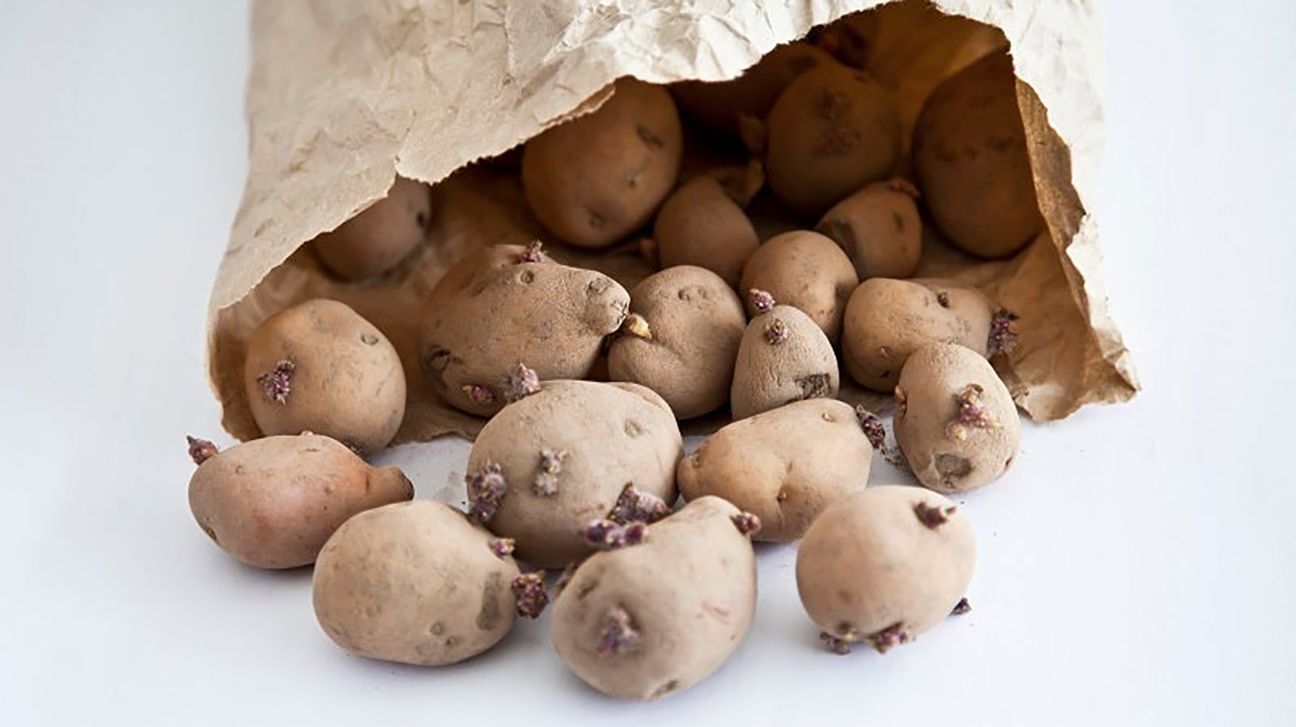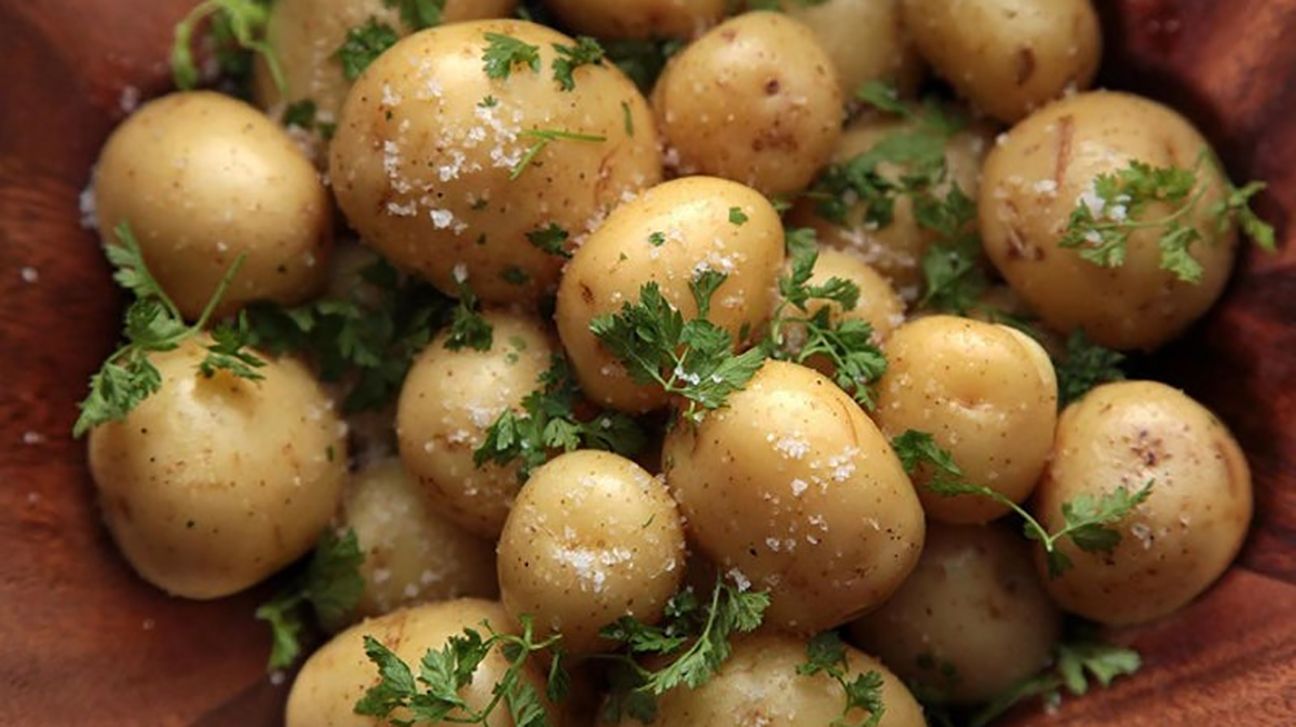Or is it an old wives’ tale? Your life might depend on knowing the truth.

We include products we think are useful for our readers. If you buy through links on this page, we may earn a small commission. Here’s our process.
Are sprouted potatoes safe to eat, or are they poisonous? And what about green spots?
You’ve probably wondered about this on occasion, when you’re rummaging through the corner of your pantry and come across a sack of potatoes with a few pointy, gnarly, sprouty things sticking out every which way. You vaguely remember hearing something about those sprouts being poisonous, but can’t recall if it’s actually true, and whether it affects the entire potato or not. So do you toss ‘em or break out the peeler and masher?
Glycoalkaloids, Green Spots, and Sprouts
It turns out that the sprouts do contain potentially harmful concentrations of glycoalkaloids, compounds that can have toxic effects (resulting in solanine poisoning if you want to get specific). But sprouted spuds aren’t necessarily duds: the potato itself is likely still safe to eat, so long as you cut away the little growths and green spots (unless the potato is also extremely soft or shriveled, which is a bad sign). And never eat a bitter potato!
In a 2006 paper published in the Journal of Agricultural and Food Chemistry, USDA research chemist Mendel Friedman explains that “glycoalkaloids are produced in all parts of the potato plant including leaves, roots, tubers, and sprouts.” They’re also found in other fruits and vegetables in the nightshade family, including tomatoes, bell peppers, and eggplants.
When consumed in large enough doses, glycoalkaloids can have some pretty nasty effects; symptoms of solanine poisoning include abdominal pain, stomach cramps, nausea, and vomiting. The levels of these toxic compounds in the root (i.e., the potato) itself are generally too low to have any bad effects. But “sprouts contain higher levels than do leaves or tubers,” therefore it’s best to avoid them.
Friedman mentions that “light and heat or mechanical injury stimulates glycoalkaloid synthesis,” which is why it’s a good idea to store your potatoes in a cool, dark place. Additionally, light triggers chlorophyll formation, which is harmless in itself. But it causes potatoes to turn green in the same spots that are at the most risk for being poisonous, acting as a visual clue for the parts you should avoid.
Bottom Line
Cut off the sprouts and any green spots before cooking, and the remainder of the potato should be safe for consumption. If you do notice an unusually bitter taste in the potato, however, this could be a sign of increased glycoalkaloids in the root and it should not be eaten. If it’s very wrinkly and soft, toss it too.
To make your spuds last longer, this is the best way to store potatoes. Plus, see how to to grow potatoes at home (even if you don’t have a garden).
Potato Recipes
In any event, once you’ve de-sprouted your potatoes, the possibilities for what you can do to them are virtually endless. Check out our favorite international potato recipes, plus a few of our most essential potato preparations below:
1. French Fries
Perfectly golden and crispy on the outside, tender on the inside: it’s every cook’s holy grail. We’ll get you there with our double-fry technique. Get our French Fries recipe.
2. Easy Potato Skins
Did someone say game day? Our recipe for this quintessential game-watching food is easy and hassle-free, so you’ll have plenty of time for keeping your eyes on the plays. Get our Easy Potato Skins recipe.
3. Perfect Baked Potatoes
Baked potatoes are the culinary equivalent of a blank canvas: you can decorate and elaborate on them up any way you want. Add some vegetables, some cheese, meat, whatever, and you’ve got a complete masterpiece of a meal in itself. Get our Perfect Baked Potatoes recipe.
4. Hash Browns
Happiness might just be a plate of crispy hash browns on a bleary-eyed Sunday morning. And ours are the crispest of them all, calling for just a little extra elbow grease and arm work to get them to their best golden brown. Get our Hash Browns recipe.
5. Herbed Potato Salad
A vinegary, herb-laden potato salad is the perfect counterpart to rich and fatty meats. Serve it next to ribs at your barbecue, sausages on German night, or pretty much anytime you’ve got a hankering for something tart and puckery. Get our Herbed Potato Salad recipe. (But if you like things creamier, check out our executive editor’s favorite Japanese Potato Salad recipe.)
6. Classic Mashed Potatoes
This is an easy, four ingredient recipe worth returning to again and again, for a dish that’s returned to again and again. Buttery and whipped fluffy, they’ll serve you well from summer cookouts to Thanksgiving. Get our Classic Mashed Potatoes recipe.
7. Perfect Roast Potatoes
If there’s an all-purpose, goes with everything version of potatoes, it’s this. A handful of rosemary and garlic gives these spuds enough flavor to stand out on their own, yet they’re still versatile enough to go with just about anything. Get our Perfect Roast Potatoes recipe. (Did you know you can actually roast leftover potato salad? See How to Use Leftover BBQ Dishes for the details.)
Related Video: How to Peel Potatoes with Your Bare Hands
Miki Kawasaki is a New York City–based food writer and graduate of Boston University’s program in Gastronomy. Few things excite her more than a well-crafted sandwich or expertly spiced curry. If you ever run into her at a dinner party, make sure to hit her up for a few pieces of oddball culinary trivia.

